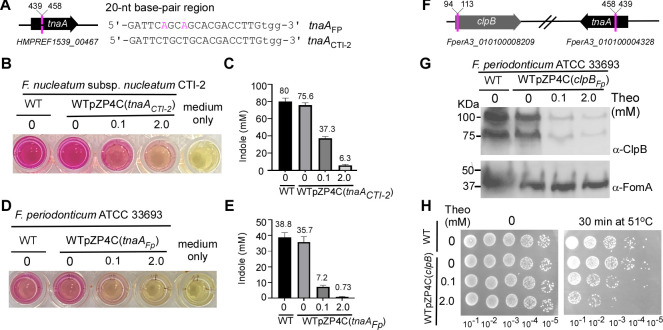Fig 5.
Apply CRISPRi system into F. nucleatum clinical strain CTI-2 and F. periodonticum. (A) The tnaA gene locus in the genome of F. nucleatum strain CTI-2 is displayed alongside a comparison of the 20-nt base-pairing region targeted within the tnaA of CTI-2 with the corresponding region in F. periodonticum. (B) Diminished indole production due to CRISPRi-mediated tnaA knockdown. The strain CTI-2 cells harboring pZP4C(tnaACTI-2) are cultivated with varying concentrations of inducers for a 14-hour growth period. Indole production is indicated by introducing Kovac’s reagent. (C and E) Indole production due to TnaA presence was qualified by indole assay. The measurement of indole production was repeated three times, and the mean values of one representative experiment performed in triplicate are reported and indicated. (D) Reduced indole production through CRISPRi-mediated tnaA knockdown in F. periodonticum wild-type cells harboring pZP4C(tnaAFp). As described in D, an indole assay is employed for validation. (F) The clpB and tnaA loci are illustrated in the genome of F. periodonticum, and the location of the targeted 20-nt base pairing regions within the clpB and tnaA genes is marked by red lines. Corresponding locus numbers for both genes are provided. (G) Validation of CRISPRi-mediated clpB is confirmed through Western blot analysis. The wild-type cells host pZP4C(clpBFp) are cultivated in a TSPC medium supplemented with varying concentrations (0, 0.1, and 2 mM) of theophylline for a 22-hour incubation. Protein samples of equal quantities are separated on a 4%–20% Tris-glycine gradient gel and subjected to immunoblotting using anti-ClpB and anti-FomA antibodies. The latter antibody serves as a loading control. (H) Heat sensitivity resulting from CRISPRi-induced clpB knockdown. WTpZP4C(clpBFp) cells are cultured at 37°C overnight with different inducer concentrations. Upon reaching the stationary phase, the cultures are serially diluted in fresh TSPC medium and spotted onto TSPC agar plates without inducers. A control group of not-heat-treated cells is included. A representative experiment of heat sensitivity is shown from three independent replicas.

